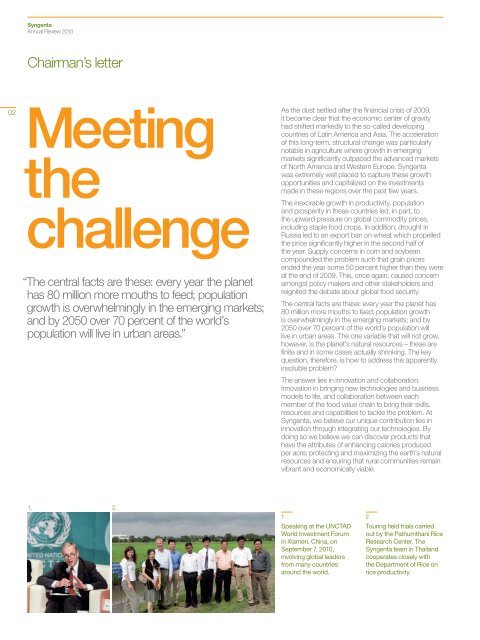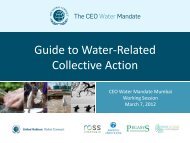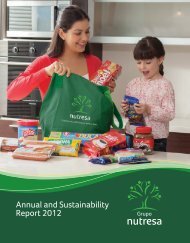Syngenta Annual Review 2010 - CEO Water Mandate
Syngenta Annual Review 2010 - CEO Water Mandate
Syngenta Annual Review 2010 - CEO Water Mandate
Create successful ePaper yourself
Turn your PDF publications into a flip-book with our unique Google optimized e-Paper software.
<strong>Syngenta</strong><br />
<strong>Annual</strong> <strong>Review</strong> <strong>2010</strong><br />
Chairman’s letter<br />
02<br />
Meeting<br />
the<br />
challenge<br />
“The central facts are these: every year the planet<br />
has 80 million more mouths to feed; population<br />
growth is overwhelmingly in the emerging markets;<br />
and by 2050 over 70 percent of the world’s<br />
population will live in urban areas.”<br />
As the dust settled after the financial crisis of 2009,<br />
it became clear that the economic center of gravity<br />
had shifted markedly to the so-called developing<br />
countries of Latin America and Asia. The acceleration<br />
of this long-term, structural change was particularly<br />
notable in agriculture where growth in emerging<br />
markets significantly outpaced the advanced markets<br />
of North America and Western Europe. <strong>Syngenta</strong><br />
was extremely well placed to capture these growth<br />
opportunities and capitalized on the investments<br />
made in these regions over the past few years.<br />
The inexorable growth in productivity, population<br />
and prosperity in these countries led, in part, to<br />
the upward pressure on global commodity prices,<br />
including staple food crops. In addition, drought in<br />
Russia led to an export ban on wheat which propelled<br />
the price significantly higher in the second half of<br />
the year. Supply concerns in corn and soybean<br />
compounded the problem such that grain prices<br />
ended the year some 50 percent higher than they were<br />
at the end of 2009. This, once again, caused concern<br />
amongst policy makers and other stakeholders and<br />
reignited the debate about global food security.<br />
The central facts are these: every year the planet has<br />
80 million more mouths to feed; population growth<br />
is overwhelmingly in the emerging markets; and by<br />
2050 over 70 percent of the world’s population will<br />
live in urban areas. The one variable that will not grow,<br />
however, is the planet’s natural resources – these are<br />
finite and in some cases actually shrinking. The key<br />
question, therefore, is how to address this apparently<br />
insoluble problem?<br />
The answer lies in innovation and collaboration.<br />
Innovation in bringing new technologies and business<br />
models to life, and collaboration between each<br />
member of the food value chain to bring their skills,<br />
resources and capabilities to tackle the problem. At<br />
<strong>Syngenta</strong>, we believe our unique contribution lies in<br />
innovation through integrating our technologies. By<br />
doing so we believe we can discover products that<br />
have the attributes of enhancing calories produced<br />
per acre; protecting and maximizing the earth’s natural<br />
resources and ensuring that rural communities remain<br />
vibrant and economically viable.<br />
1. 2.<br />
1<br />
Speaking at the UNCTAD<br />
World Investment Forum<br />
in Xiamen, China, on<br />
September 7, <strong>2010</strong>,<br />
involving global leaders<br />
from many countries<br />
around the world.<br />
2<br />
Touring field trials carried<br />
out by the Pathumthani Rice<br />
Research Center. The<br />
<strong>Syngenta</strong> team in Thailand<br />
cooperates closely with<br />
the Department of Rice on<br />
rice productivity.











